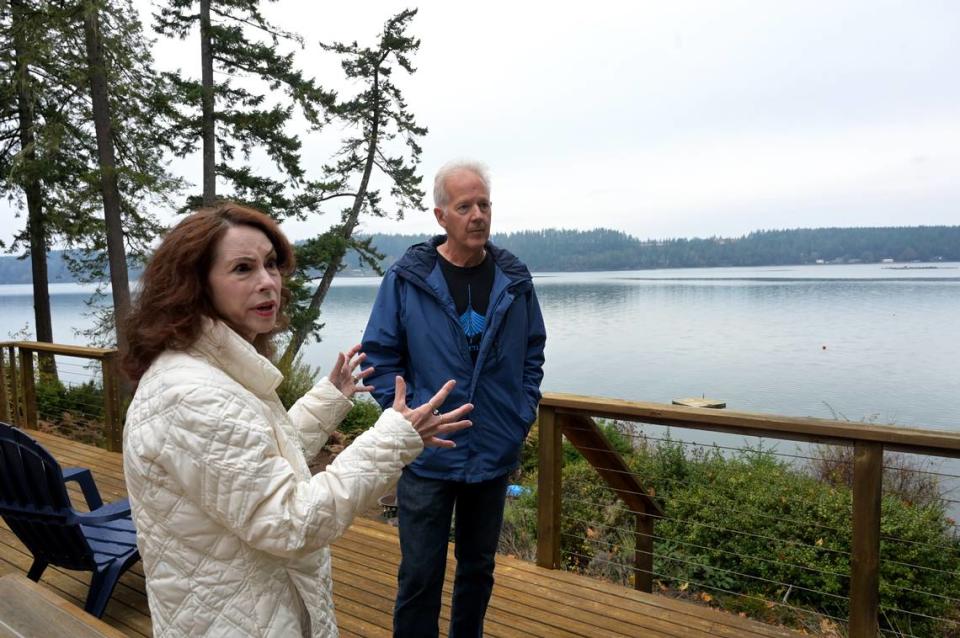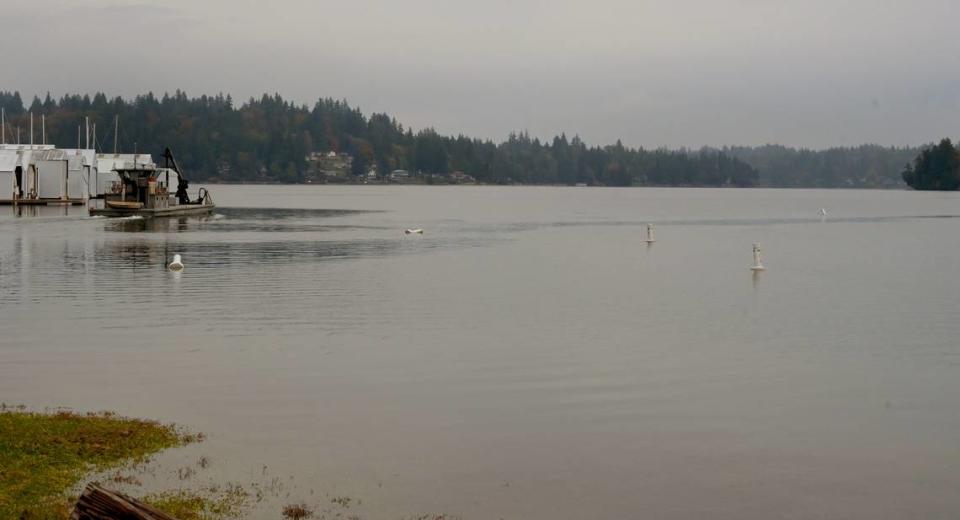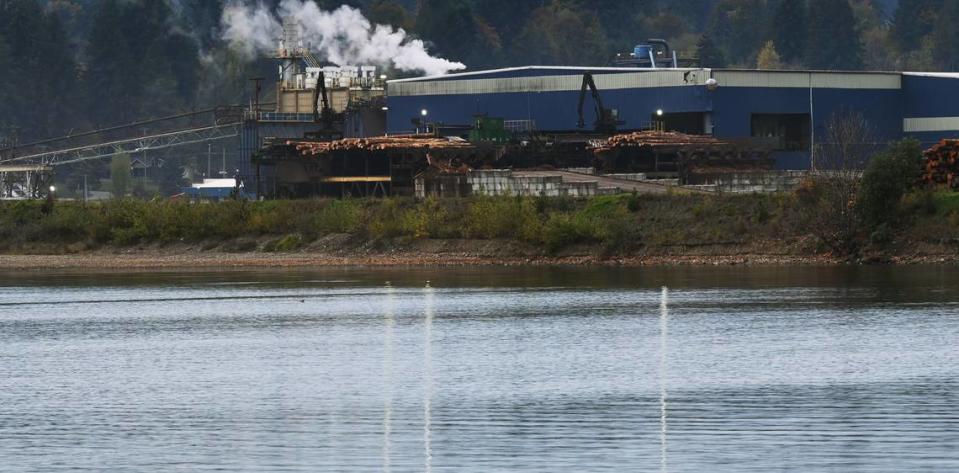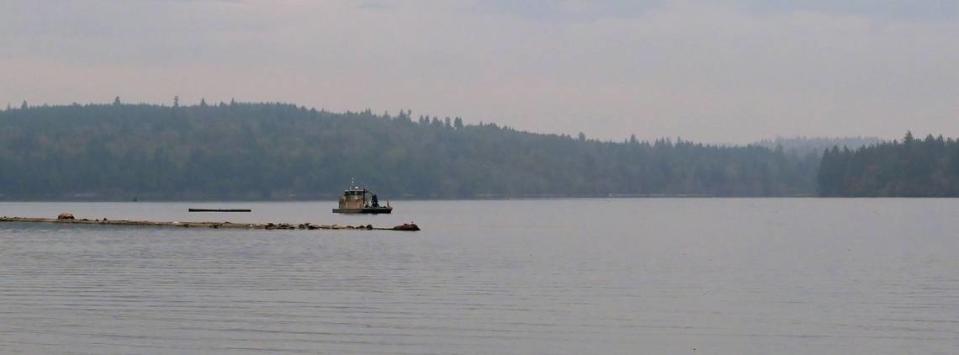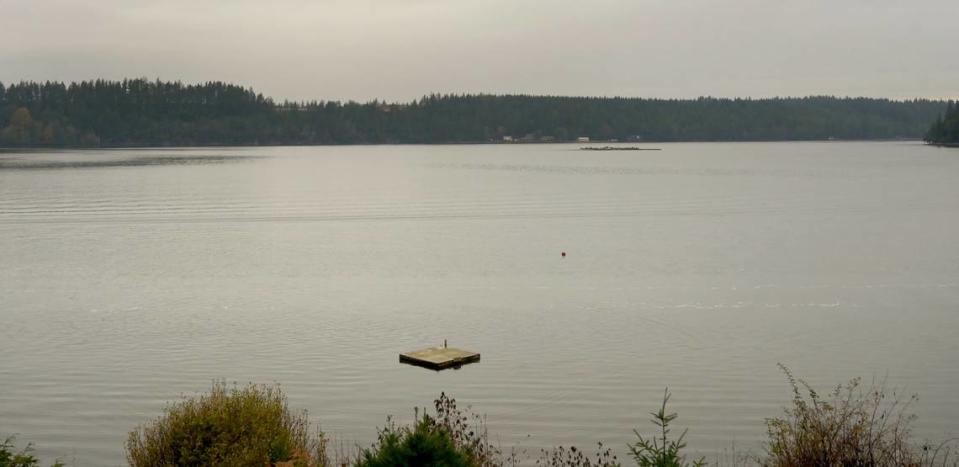Shelton residents push back against proposed Taylor Shellfish oyster farm in Oakland Bay
Mark and Christin Herinckx had only been living in their home on Oakland Bay for a year before they learned about the proposal by Taylor Shellfish: a 50-acre oyster farm, the size of several aircraft carriers, in the middle of the bay right behind their new house.
Christin told McClatchy in an interview that her first thought was “this is crazy.” Mark said his first thought was “are you kidding me?”
The couple had worked in modest jobs most of their lives to finally purchase a home for their retirement in Shelton. Mark worked in the carpet-cleaning business, while Christin worked for a telephone company. They looked forward to a home where they could find some rest and relaxation after years of hard work.
But since news of the proposal by Taylor Shellfish, the Herinckx’s have been spending their time and energy trying to thwart it with the help of their neighbors around the bay, as well as other organizations.
“Homeowners should not have to open their wallets to fight big corporations,” they told McClatchy. “We didn’t move out here to fight.”
The proposal
The water behind the Herinckx’s and others’ homes in Oakland Bay is managed by the Washington state Department of Natural Resources.
On its website, DNR says that it manages “seven specific trusts to generate revenue and preserve forests, water, and habitat.”
“DNR now manages 5.6 million acres of forest, range, agricultural, aquatic, and commercial lands for more than $200 million in annual financial benefit for public schools, state institutions, and county services,” it says.
DNR is able to lease that land and aquatic space to private entities through an application process.
Tom Gorman, the division manager for aquatic resources at DNR, told McClatchy that Taylor Shellfish initially submitted an application for the lease in 2021. A standard leasing term through DNR is 12 years, although that can be negotiated, he said.
Gorman said the agency does aquatic lands leasing for a variety of other uses that aren’t aquaculture, such as marinas.
In May, Oakland Bay residents, with the help of the Coalition to Protect Puget Sound Habitat, submitted their own application for rights to the aquatic area to DNR, proposing that the area of the bay being considered by Taylor Shellfish be used for research and conservation purposes instead.
“We’re working with both applicants. We requested some additional information from the coalition,” Gorman said. “Likewise, Taylor’s was received earlier, so we’ve been working with them longer, but both are still in the early stages of review and requesting of additional information.”
But ultimately the agency can only provide one lease to one entity for the area, and some factors would be taken into consideration for which one gets the lease, he said. For example, a solution could be for one of the entities to find another area to conduct their operations.
“But at this stage, we’re just not at the point of making a decision on either application,” Gorman said.
Gorman acknowledged the concerns from residents and said the agency had received multiple letters.
“We provided feedback to some of those,” he noted. “So, we’re trying to be open and listen to their concerns.”
The proposal from Taylor Shellfish has been approved on a local level by the Mason County Hearing Examiner. Residents of Oakland Bay then submitted a request for reconsideration on Oct. 30
Why neighbors oppose the proposal
DNR’s mission statement says that for leases to be administered, an entity must be in line with DNR’s goals: to encourage direct public use and access, to foster water-dependent uses, to ensure environmental protection, and to utilize renewable resources.
But residents and others do not believe that the Taylor Shellfish proposal falls in line with that mission.
Laura Hendricks, the director of the Coalition to Protect Puget Sound Habitat, said there are multiple concerns with an oyster farm in the area.
Hendricks called the proposal by Taylor Shellfish, a multi-million dollar company, particularly “egregious” because “it will certainly go against the four objectives that DNR has.”
Oakland Bay also has a history of pollution, as a former pulp mill in the area caused contamination to the bay. Hendricks and residents believe this makes the area unsuitable for shellfish harvesting.
The most recent report from the Department of Ecology released in 2014 showed that Oakland Bay contained “moderate to high concentrations” of dioxins when it was tested in 2011.
Dioxins are “persistent organic pollutants,” which means they take a long time to break down once introduced into an environment, according to the U.S. Environmental Protection Agency’s website. Not only can dioxins cause cancer, they can cause “reproductive and developmental problems, damage to the immune system, and can interfere with hormones,” the agency said.
While found all over the world, dioxins accumulate in food chains mainly in animals’ fatty tissues.
“More than 90% of typical human exposure is estimated by EPA to be through the intake of animal fats, mainly meat, dairy products, fish, and shellfish,” the agency said on their website.
The competitive lease submitted by Coalition to Protect Puget Sound Habitat looks to study the extent of that pollution, conserve the area, and leave it open for public access as well as whales and marine wildlife. Hendricks said they eventually want to independently test oysters by hanging them from rafts in the area and by sending them to a facility that can test for contaminants.
“We need to know what kind of effects are underneath those rafts and around those rafts,” Hendricks said.
Additionally, Hendricks said the oyster bags that would be used by Taylor Shellfish to grow and harvest oysters are made out of high density polyethylene, which fragments when the bags are cut, leading to microplastics going into the ocean as well as the oysters.
Polyethylene also can cause health problems, such as asthma and hormone disruption, according to studies.
The pollution isn’t the only issue, Hendricks and the Herinckx’s said. Lights and noise from the operation would be permitted around the clock. The smell from the operation is a concern as well. Public access to the waterway would also be limited.
“This is a classic case of environmental injustice,” said Christin Herinckx.
Hendricks said the organization is looking into legal remedies if DNR approves the Taylor Shellfish lease.
Taylor Shellfish weighs in
Bill Dewey, director of public affairs for Taylor Shellfish, told McClatchy in an interview that the company has done its best to address concerns with residents along Oakland Bay.
“We’re doing our best here with this project to make it fit with the community, and address people’s concerns,” he said. “And all of those comments in our responses were taken into account when (the hearing examiner) approved permits.”
Dewey said the reason Taylor Shellfish has its sights on Oakland Bay is because the company has a long history in the area. He said Oakland Bay already contains Taylor Shellfish’s major oyster seed-producing facility and that the purpose is to enhance the company’s seed production.
The floating bags used by Taylor Shellfish that are a part of the proposal in Oakland Bay are a “method that’s used throughout the world for growing oysters,” he said.
Dewey said that the Taylors have worked on water quality in the bay for years.
“We work really hard in all of our growing areas with local county governments and with the State Department of Ecology and on federal regulations with EPA to try to ensure that we have appropriate regulations in place and that they’re being enforced,” Dewey said.
While Taylor Shellfish does not do any independent third-party testing, Dewey said they rely on the state Department of Health to do the testing on processing plants for sanitation and traceability requirements. DOH also tests the waters to make sure they’re free of pollutants, he said.
Dewey pushed back on claims from residents that the company is greedy.
“I just don’t buy into the greedy comment,” he said. “It’s not greed. Just like any other business, they’re in business to make money and they’re generous with that money that they make.”
He said the company gives back to the communities it operates in, such as Mason County where Taylor Shellfish is headquartered. In addition, he said the company would contribute to the area by donating to the local yacht clubs and improving a boat launch in Shelton. The public would still have access to 16 acres of tidelands in the bay, he said.
Department of Health responds
Scott Berbells, manager of the shellfish growing section at the state DOH, told McClatchy in an interview that to assess for risk, the agency goes by federal regulations.
Different areas can have different risks and classifications, he said. This means that certain areas can be classified as approved areas, while others prohibit shellfish harvesting altogether. Some areas are conditionally approved depending on other mitigating factors like rainfall.
Restricted classifications don’t “meet the approved standard, there’s no predictable condition, people can still harvest but they have to move the product, they pick it up from one area, they move it to another area and let it sit for a length of time so the shellfish can purge whatever contaminants may be present,” Berbells said.
In Oakland Bay, for example, he said the department tests the water about 12 times a year to check for fecal coliform bacteria, salinity and temperature. Primarily they are checking for fecal bacteria and viruses, he said.
“We also look at other potential contaminants when our research shows there may be an issue,” Berbells said.
The outcomes of the water testing determine what the risks are, and if shellfishing can be allowed at a given time.
Berbells said the health assessment study from Oakland Bay in 2011 sampled at a number of sites within the shellfish growing area, including the prohibited area.
“We sent those samples to a lab,” Berbells said. “They were analyzed for dioxin and again, our toxicologists evaluated those results, and summarized and formed conclusions based on the results that we found for Oakland Bay.”
“According to a health consultation from the Department of Health, even people who eat large amounts of shellfish from Oakland Bay are very unlikely to see harmful health effects from the shellfish,” the Department of Ecology said in an Oakland Bay status update online. “The health assessment also determined that touching, breathing in, or accidentally eating contaminated sediment from Oakland bay is very unlikely to harm people’s health.”
Berbells said no other studies like the 2011 one have been conducted since then because “there’s not an ongoing source of dioxin into Oakland Bay — this was historic industrial activities that lead to these potential problems.”
DOH won’t conduct further studies to that degree unless there’s a new concern that crops up.
The state pays attention to Oakland Bay when it comes to shellfish harvesting and quality, Berbells said.
“There’s been a substantial amount of work by partners, meaning DOH, other state partners, and local health conservation districts to basically protect this area to find and fix pollution sources when they become available,” Berbells said. “It’s an area that a lot of shellfish come out of and it’s very important to us that it’s safe for harvest. So there is a lot of work by a lot of people to maintain the safety of Oakland Bay for shellfish harvesting.”
The Seattle Times reported in April that while Oakland Bay met water quality standards at the time, the area was “at risk of harvest restrictions due to bacterial pollution” after fecal pollution restricted shellfish harvesting in other areas.
Moving forward
In a letter from Oakland Bay residents Ginny and David Douglas to the Mason County Hearing Examiner, they pushed back on Taylor Shellfish’s motion for reconsideration after the examiner’s first decision was made.
“Taylor got almost everything it sought in the Examiner’s decision, and now seeks even more,” they wrote.
For one, they said, Taylor Shellfish requested modification of proposed working hours that were initially presented to the public.
Additionally, the Douglas’ told the examiner that third-party monitoring “is by far the most critical restriction and must be upheld to protect the ecosystem of the bay.”
“The request that Taylor be allowed to self-monitor is laughable,” they wrote. “In our estimation, it is like a ‘fox guarding the henhouse.’ If this revision is accepted, it demonstrates very clearly that Mason County endorses Taylor’s lack of concern for the Oakland Bay environment, for the individual Oakland Bay property owners, and for any county or state rule or regulation which may hinder Taylor Shellfish’s collection of more and more money and profits.”
Furthermore, the Herinckx’s argued that if Taylor Shellfish is allowed to move forward with the proposal, they will try to replicate the process “all around the Puget Sound.”
Hendricks said people travel from all over the world to see Washington’s whales and marine life, but “they’re not gonna see anything if we keep industrializing our waterways and letting for-profit corporations” take over.
